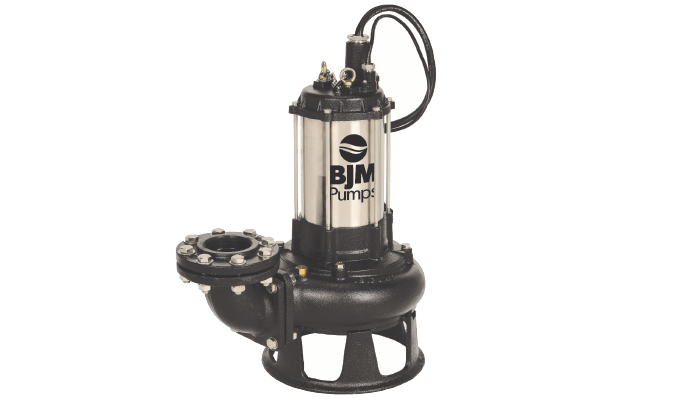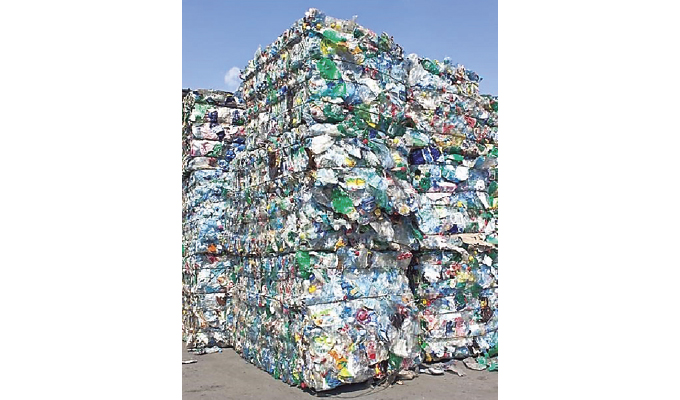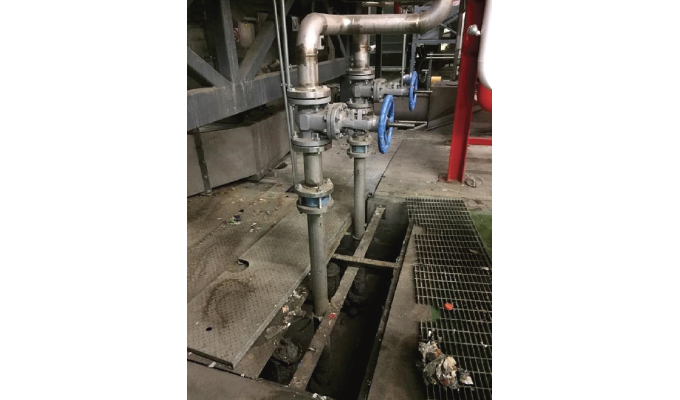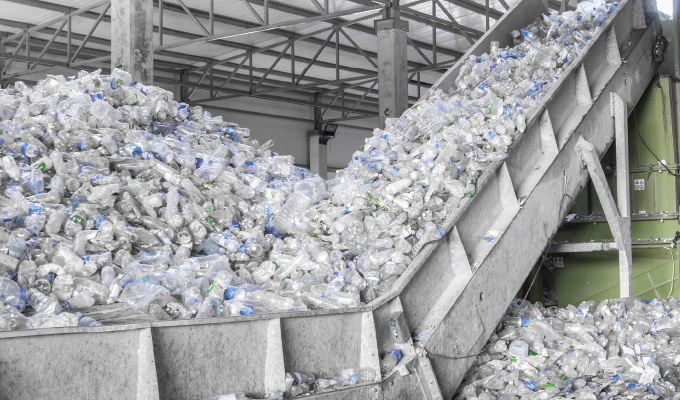Americans discard an estimated 34 million tons of plastic each year, creating the need for more plastic recycling facilities in the United States. In September 2016, a brand new bottle recycling center opened in North Carolina to process about 75 million pounds of reusable plastic bottles. Prior to construction, the recycling company consulted with Tencarva Machinery to discuss rotating equipment that would be needed throughout the facility.
UNDERSTANDING THE APPLICATIONS
This new recycling facility is designed to receive large bales of compressed PET bottles—bales approximately 6 cubic feet in size. These bales are dismantled, and the bottles are sorted and shredded into much smaller plastic pieces prior to being sent through a series of processes. Because PET (polyethylene terephthalate) is semi-porous and typically absorbs food and beverage molecules, the shredded plastic must be finely chopped into “flakes” and thoroughly washed and dried. The cleaned, processed plastic is then bagged and distributed to other companies who use recycled plastics to manufacture consumer packaging, plastic banding, and a range of other goods.
The design engineers specifying the pumping systems worked with Derrick Heard at Tencarva, explaining that there would essentially be two sumps—a primary and a secondary pit—used for the rigorous cleaning process. During the initial grinding and cleaning, wash down water, plastic pieces, dirt, soap, scum, and residue would all be collected in the primary wash down sump. This material would then be pumped through clarifiers and screens to separate the plastic from the wash down wastewater. While the plastic would be sent through for drying, the wash down wastewater would be sent to the secondary pit. The pumps in the secondary sump would be responsible for reliably transporting the wash down wastewater to the on-site wastewater treatment plant. The wastewater would be treated on-site, with the facility technicians making sure all plastic and sludge had been removed prior to sending the wastewater downstream to the municipal sewer system.

PICKING OUT THE RIGHT PUMPS
After speaking with the design engineers, it was clear to Heard that there were some key requirements that needed to be considered in order to select the right pumps for these specific sump applications:
The pumps needed to withstand high temperatures. The temperature of the wash down water was estimated to reach temperatures between 131 and 140 degrees Fahrenheit (55 and 60 degrees Celsius), which is too hot for standard submersible pump motors. Submersible pumps typically rely on the fluid being pumped to cool the motor; which is why most submersible pumps cannot withstand pumping liquids at temperatures higher than 104 degrees Fahrenheit. Temperatures higher than 104 degrees Fahrenheit (40 degrees Celsius) typically cause standard submersible motors to fail.
The pumps had to be corrosion-resistant. The wash down water would include cleaning chemicals that would cause the oatmeal-like slurry to be 2 percent caustic. For this reason, it was important to select a durable pump with the right metallurgy to minimize abrasion / corrosion.
The pumps must shred the plastic pieces. The plastic solids entering the primary sump needed to be shredded into even smaller pieces so they could be transported to the next stage of the process. This severe application required a shredder pump.
Heard immediately thought of BJM Pumps, explaining, “I knew BJM had a Fahrenheit Series—not just a submersible that could handle high temperatures, but one that could shred too. The combination is unique in the industry—and prior to BJM Pumps—there really wasn’t a high temperature option that could do all these things.”
Heard recommended the BJM Pumps’ SKG Fahrenheit Series Submersible Shredder Pumps to the design engineers. In his recommendation, he shared the key features of the SKG-F Submersible Shredder Pumps:
The SKG Fahrenheit® Series Submersible Shredder Pump is proven to reliably handle very hot liquids—up to 200 degrees Fahrenheit (93 degrees Celsius).
The SKG Fahrenheit® Series Submersible Shredder Pump is designed with patented RAD-AX® Dual Shredding Technology, which employs both radial and axial shredding. A rotating cutter bar with serrated edges traps and shreds solids against the sharp grooves of a radial cutting ring while multiple axial cutting bars shred any leftover material exiting the radial cutters.
All the shredding components of the SKGF Submersible Shredding Pump are manufactured in hardened 440C Stainless Steel (Rockwell hardness of 55C plus), which means this durable pump is constructed to resist wear and operate longer than most submersible shredder pumps currently available to the market.

Two impeller trims are available for each SKGF model to expand hydraulic coverage, with large solids easily passing through impeller and volute. Controlled Shredding System Efficiency alleviates potentially high surge load to the motor.
The SKGF Submersible Shredder Pump relies on a high-torque, four-pole motor to ensure solidsladen wastewater can be moved efficiently. The motor is protected by an oil-lubricated double mechanical seal design, with separate lip seal.
Manufactured with a corrosion-resistant stainless-steel motor housing, the SKGF Submersible Shredder Pump has motor winding protection that includes NEMA Class R motor insulation – allowing motor temperatures to rise up to 428 degrees Fahrenheit (220 degrees Celsius) without damage. Automatic thermal switches embedded in the motor windings protect the motor if the temperature or amperage rise too high. When the motor cools, the automatic switches will reset and allow the pump to restart.
The design engineers reviewed Heard’s recommendation to put two SKG37CF Submersible Shredder Pumps into the primary wash down sump and two SKG15CF Submersible Shredder Pumps into the secondary wastewater sump. They also watched the video to see how the RAD-AX® Dual Shredding Technology is proven to obliterate solids. After a thorough review of the entire pumping system specs, the decision was made to purchase and install the BJM Pumps.
In February 2016, two 5-horsepower SKG37CF Submersible Shredder Pumps were installed in the primary sump, and two 2-horsepower SKG15CF Submersible Shredder Pumps were installed in the secondary sump. Heard was on-site in August 2016 when the pumps were started up, with the SKG37CF’s pumping 275 gallons per minute at 35 feet of head and the SKG15CF’s pumping 115 gallons per minute at 35 feet of head.
Since start-up, Heard has repeatedly visited the bottle recycling facility to check on these pumps. “Other than the one time we had to check the controls operation of the two sumps and clear the nasty slurry build-up off the floats, the BJM Pumps have been working great in the sumps,” states Heard. “They’re really reliable pumps.”

ABOUT THE AUTHOR
Steve Mosley is regional manager for BJM Pumps. BJM Pumps, headquartered in Old Saybrook, Connecticut, has been providing fluid handling solutions for industrial and municipal services since 1983. Over its thirty-year history, BJM Pumps has grown quickly by supplying world class pumps and accessories, priced competitively, through its global network of stocking distributors. For more information, visit www.bjmpumps.com.
_______________________________________________________
MODERN PUMPING TODAY, November 2018
Did you enjoy this article?
Subscribe to the FREE Digital Edition of Modern Pumping Today Magazine!
![]()


